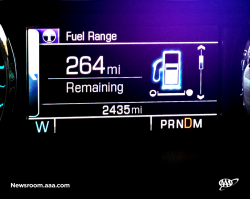
— Vehicle "miles-to-empty" accuracy is being questioned by researchers who say drivers shouldn't bet their lives on the feature found on the instrument panels of millions of vehicles.
The feature is supposed to warn a driver by estimating the number of miles the vehicle is getting per gallon of fuel, and how many miles can be traveled before the tank is empty.
But researchers from AAA and the Automotive Research Center of the Automobile Club of Southern California found the miles-to-empty accuracy can be greatly affected by how a person drives. Additionally, the estimate consistency can also vary over shorter trips compared to longer road journeys.
Considering recent gas prices are higher than in the past seven years, researchers used a dynamometer, which is essentially a large treadmill for vehicles, and put the vehicles through driving situations ranging from highway speeds, to city driving and being stuck in traffic.
These manufacturers and vehicles were used for the test.
- 2019 Hyundai Elantra
- 2019 Toyota Tacoma
- 2019 Mazda CX-5
- 2019 Ford Escape
- 2019 Nissan Sentra
- 2019 Dodge Grand Caravan
- 2018 Mercedes-Benz CLA 250
- 2019 MINI Cooper
- 2019 Chevrolet Malibu
- 2019 Volkswagen Jetta
- 2018 Subaru Outback
- 2019 Honda Accord
- 2019 Kia Optima
- 2020 BMW 740i xDrive
- 2020 Volvo XC90 T6 AWD
- 2020 Land Rover Range Rover Sport
According to researchers, the accuracy of some miles-to-empty displays was overestimated by 6.4%, or more than 2 miles per gallon, while one vehicle underestimated the fuel economy by 2.8%.
The range estimates seemed to react based on the fuel economy of the recent drive cycles, leading researchers to believe the accuracy of the range display at a given point is affected by changes in driving conditions.
AAA also found evidence the automakers use built-in underestimation to reduce the chance of suffering from an empty gas tank.
Researchers say the sometimes-irregular test results shouldn't prevent a driver from using the miles-to-empty feature because it's a tool to understand the connection between fuel economy and driving styles.
AAA recommends a driver reset the trip meter after filling the tank and then watch how the fuel economy changes as driving conditions change.




